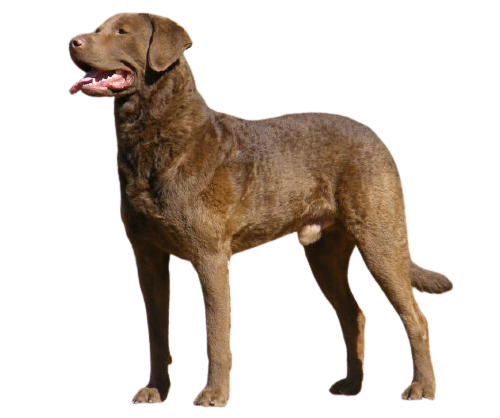
Chesapeake Bay Retriever
USD $500-$600 Price Avg.
Gun Dog
Group
Purebred
Breed Type
Large
Size
10-13 years
Lifespan
Breed Information
| Group | Gun Dog |
|---|---|
| Popularity/Rank | 43 |
| Origin | United States |
| Other Names | CBR, Chesapeake, Chessie |
| Breed Type | Purebred |
| Price (Avg.) |
USD $500-$600
How much does it cost to purchase a Chesapeake Bay Retriever? The price of a Chesapeake Bay Retriever will vary from breeder to breeder as well as from place to place. As a rough guide, you should expect to pay between $500 to $600 per Chesapeake Bay Retriever if you purchase from a reputable breeder. Prices will be higher for show-quality dogs with a distinguished pedigree. Adult dogs who have already been trained may cost even more. It is usually less expensive to adopt a Chesapeake Bay Retriever through a shelter. |
| Size | Large |
| Weight |
Male: 65-80 pounds (29-36 kg),
Female: 55-70 pounds (25-32 kg) |
| Height |
Male: 23-26 inches (58-66 cm),
Female: 21-24 inches (53-61 cm) |
| Lifespan | 10-13 years |
| Recognized by |
AKC, FCI
The American Kennel Club in 1878 as a Sporting breed. And FCI in the Retrievers - Flushing Dogs - Water Dogs group, in the Retrievers section. |
| Purpose | Water retriever |
| Date of Origin | 1800s |
| Ancestry | Newfoundland dog |
Appearance & Maintenance
| Coat | Waterproof |
|---|---|
| Coat Colors | Brown, Deadgrass, Light, Sedge |
| Grooming Level | |
| Shedding Level | |
| Eye Color Possibilities | Amber, Brown |
| Nose Color Possibilities | Brown |
| Coat Color Possibilities | Brown, Red |
| Coat Length | Medium |
| Coat Density | Normal |
| Coat Texture | Wavy |
| Recommended Brushes | Comb, Nail Clipper, Slicker Brush |
| Brushing Frequency | Weekly |
Breed Characteristics
| Temperament | Affectionate, Caring, Cheerful, Defensive, Dominant, Happy, Intelligent, Peaceful, Protective, Quiet |
|---|---|
| Intelligent | |
| Trainability | |
| Playfulness | |
| Sensitivity Level | |
| Affection Level | |
| Social Interaction Required | |
| Barking | |
| Watchdog Ability | |
| Territorial | |
| Biting Force | Low |
| Mouthiness | |
| Impulse to Wander or Roam | |
| Prey Drive | |
| Adaptability | |
| Tolerates Being Left Alone | |
| Fighting Dog | Not really |
Good & Friendly with
| Apartment Life Friendly | |
|---|---|
| Stranger Friendly | |
| Kid-Friendly | |
| Cat Friendly | |
| Dog Friendly | |
| Office Friendly | No |
| Senior Citizens Friendly | |
| Pet Friendly | |
| Friendly with First Time Owners | Yes |
| Service Dog | Not really |
| Therapy Dog | Not really |
| Detection, Sniffer or Security Dog | Not really |
| Search and Rescue Dog (SAR) | Not really |
| Boat Dog | Yes |
| Cart Pulling or Drafting Dog | Not really |
Health Elements
| Health Issues | |
|---|---|
| Health Problems | Bloat, Cerebellar Abiotrophy, Hip Dysplasia, Progressive retinal atrophy (PRA) |
| Hypoallergenic | No |
| Energy Level | |
| Exercise Required | |
| Sleeping Required | |
| Weight Gain Potential | |
| Weather & Climate | Prefers average to cold weather conditions |
| Stinkiness | Medium |
| Drooling tendency | |
| Activity Level | High |
| Rec. Walk Mileage Per Week | 14 miles |
| Minutes of Activity Per Day | 90 minutes |
Food & Costing
| Avg. Daily Food | 3 to 4.5 cups of high-quality dry food a day, divided into two meals. |
|---|---|
| Cups Per Day | 2.8 cups |
| Daily Cost | $1.50 - $1.90 |
| Monthly Cost | $39.00 - $52.00 |
Reproducibility
| Gestation Duration | 60-64 days |
|---|---|
| How often can the Chesapeake Bay Retriever have a litter? | Once a year. |
| Litter Size | 7-9 puppies (Once a year.) |
Description
The Chesapeake Bay Retriever is a medium-sized breed of dog that originated in the United States. It is a strong, muscular, and active breed that is known for its intelligence and loyalty. The Chesapeake Bay Retriever has a thick double coat that comes in shades of brown, ranging from light to dark. Its eyes are usually dark brown or black and its ears are small and triangular.
When it comes to size, the Chesapeake Bay Retriever typically stands between 21-26 inches tall at the shoulder and weighs between 55-80 pounds. The average lifespan of this breed is 10-12 years.
The personality of the Chesapeake Bay Retriever is one of intelligence, loyalty, and independence. They are very active dogs who love to play fetch or go on long walks with their owners. They can be quite stubborn at times but they are also very loyal companions who will always be there for their owners when needed.
The Chesapeake Bay Retriever is generally friendly with other dogs, children, and other animals if properly socialized from an early age. They can be protective of their family but they do not tend to show aggression towards strangers unless provoked or threatened in some way.
The temperament of the Chesapeake Bay Retriever is one that requires patience and consistency from its owner as it can be quite independent at times due to its strong willed nature. This breed needs plenty of exercise as well as mental stimulation in order to stay happy and healthy so it’s important for owners to provide them with plenty of activities throughout the day such as walks or games like fetch or tug-of-war which will help keep them entertained while also providing them with much needed physical activity too!
When it comes to health issues, the Chesapeake Bay Retriever may suffer from hip dysplasia which can cause lameness in older dogs if not treated properly by a veterinarian; however this condition can often be managed through proper dieting and exercise routines so it’s important for owners to keep an eye on their pet’s weight levels throughout their life time in order to prevent any potential problems arising later on down the line! Other health issues include eye problems such as cataracts which may require surgery if left untreated; however these conditions are rarer than hip dysplasia so regular check ups with your vet should help catch any potential problems before they become serious!
In terms of adaptability level, this breed does best when living indoors with access to outdoor space where they can run around freely; however they do not do well when left alone for long periods so it’s important for owners who work full time jobs outside the home make sure someone else (such as a family member) can look after them during those hours away from home!
Overall, owning a Chesapeake Bay Retriever dog has many benefits including being an intelligent companion who loves spending time outdoors playing games like fetch or going on long walks; plus they have relatively low maintenance needs when compared with other breeds making them ideal pets for busy households!
History
The Chesapeake Bay Retriever is a breed of dog that was developed in the United States in the 19th century. The breed was almost extinct by the early 20th century, but it was revived and became popular again in the mid-20th century. The Chesapeake Bay Retriever is descended from two different types of dogs: English retrievers and Newfoundland dogs. The English retrievers were brought to the United States in the 18th century, and the Newfoundland dogs were brought to the United States in the early 19th century.
The Chesapeake Bay Retriever was recognized as a breed by the American Kennel Club in 1878. The breed was named after the Chesapeake Bay, where it was used for retrieving ducks that had been shot by hunters. The Chesapeake Bay Retriever is a large breed of dog, with males weighing up to 100 pounds and females weighing up to 85 pounds. The breed is known for its thick, oily coat, which is waterproof and helps protect the dog from cold water and icy conditions. The coat can be any color, but it is most commonly brown or black.
The Chesapeake Bay Retriever is a versatile breed of dog that can be used for hunting, retrieving, obedience, agility, and even as a family pet. The breed is intelligent and trainable, but it can also be stubborn and independent at times. The Chesapeake Bay Retriever is an active breed that needs plenty of exercise and space to run around.


